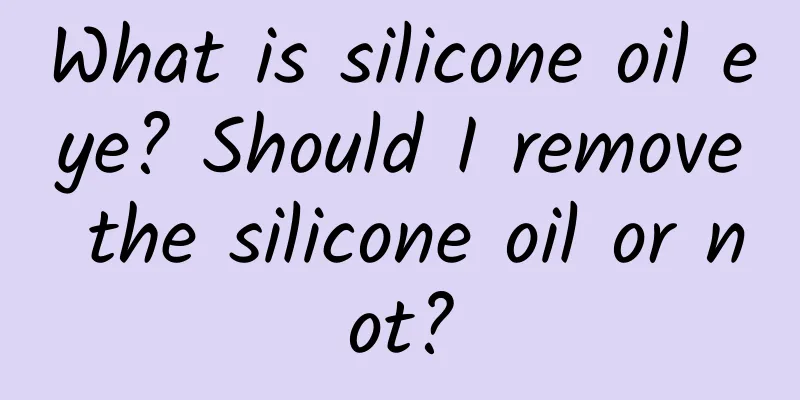What is silicone oil eye? Should I remove the silicone oil or not?

|
At the fundus disease clinic of Aier Eye Hospital affiliated to Wuhan University, we often hear doctors use "silicone oil eyes" to describe the eye conditions of some patients. When you first hear this term, you may be a little confused: Silicone oil eyes? What is it? It sounds a bit strange and scary... Next, the editor will take you to understand it. What is silicone oil eye? Wu Jianhua, director of the Aier Eye Hospital affiliated to Wuhan University, introduced that the scientific name of silicone oil is polydimethylsiloxane, which is a colorless, non-toxic, transparent oily liquid that is harmless to the human body. It has high stability and is widely used in skin care, beauty cosmetics, daily use and medical diagnosis and treatment. In ophthalmology, silicone oil is mainly used to fill the vitreous cavity. The eyeball filled with silicone oil in the vitreous cavity is called "silicone oil eye". What does it mean to inject silicone oil into the eyes? Silicone oil is a special filling material used in retinal detachment surgery. Its main purpose is to better reattach the retina. If the silicone oil stays in the eye for too long, it can easily lead to silicone oil emulsification. Recently, a 55-year-old Uncle Cheng came to the outpatient clinic of the Department of Fundus Diseases. Uncle Cheng underwent vitrectomy + silicone oil filling surgery in a hospital in Hubei Province in July 2020 due to "left eye trauma causing decreased vision". After he was discharged from the hospital, Uncle Zhao did not have a timely follow-up examination due to work reasons, and he did not pay much attention to his eyes. In February this year, the patient came to our hospital for treatment due to eye discomfort. Director Wu found that the silicone oil in Uncle Cheng's left eye had emulsified and needed surgery in time. Recently, Director Wu performed "silicone oil removal + lens implantation" on Uncle Cheng, and Uncle Cheng's vision recovered well after the operation. Director Wu explained that silicone oil filling is a common method in retinal detachment surgery, but silicone oil should not be permanently filled in the eyes. It is generally recommended to remove it after a period of time. The specific time is determined based on the patient's actual situation. Q: How long does it take to remove the silicone oil? Answer: In clinical work, after intraocular silicone oil filling surgery, doctors will tell patients that it should be removed surgically as soon as possible, generally around three to six months later, if the retina is well restored. Q: What harm will it cause if the silicone oil is not removed? Answer: If silicone oil stays in the eyes for too long, it can easily lead to silicone oil emulsification. Once silicone oil is emulsified, first of all, it will cause a large number of silicone oil droplets in the eye, increasing the difficulty of removing silicone oil; secondly, emulsified silicone oil can easily block the chamber angle, thereby causing secondary glaucoma; thirdly, emulsified silicone oil can also cause bullous keratopathy. |
>>: As autumn winds blow, it’s time to eat crabs. Be careful of allergies and go to the pharmacy
Recommend
Can I eat ice cream during late pregnancy?
Ice cream is a very popular food in the hot summe...
A seasoning that makes all boiled dishes delicious, thank you Hainanese people!
In the past two years, more and more niche new pr...
How do you know if you are a virgin?
Asian men generally have a virgin complex, and no...
Why does lupus particularly favor women? How serious is it?
On the evening of December 12, 2023, Zhou Haimei&...
Polycystic ovary old medical association a stick
The uterus and ovaries are one of the most import...
Early prevention and early treatment can open up the life "supply line" for patients with coronary heart disease
Editor’s Note: As the "three major killers&q...
Is it good to lose weight one week after menstruation?
Many fat girls worry about losing weight, and the...
A younger brother accompanied his sister to see a doctor and both were diagnosed with thyroid cancer. How to protect the thyroid gland?
Science Fiction Network, February 16 (Jin Kaiyi) ...
Feeling short of breath during pregnancy
Women often experience chest tightness and shortn...
How long do contractions last before labor begins?
Although cesarean section technology is becoming ...
How to make your boyfriend feel more comfortable How to make your boyfriend hard quickly
When men and women are dating, the relationship w...
Why does urethra pain occur when women urinate?
Urethral pain is a private disease that many wome...
Why do I have back pain and breast pain?
We all know that in life, many women will experie...
When is the best time for pregnant women to take a walk?
Pregnant women should pay more attention to exerc...
Will cervical erosion recur after surgery?
In fact, women do not have to worry too much afte...









